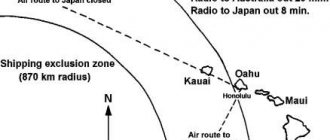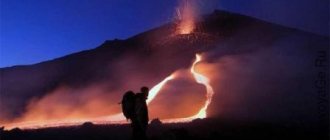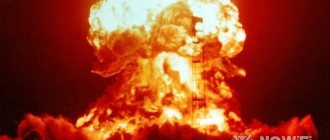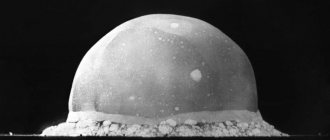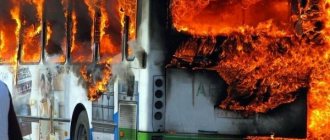So, let's say a low-yield nuclear bomb explodes in your city. How long will you have to hide and where to do it to avoid consequences in the form of radioactive fallout?
Michael Dillon, a scientist at Livermore National Laboratory, spoke about radioactive fallout and survival techniques. After much research, analysis of many factors and possible developments, he developed a plan of action in the event of a disaster.
At the same time, Dillon's plan is aimed at ordinary citizens who have no way to determine which way the wind will blow and what the magnitude of the explosion was.
Little bombs
Dillon's method for protecting against radioactive fallout has so far been developed only in theory. The fact is that it is designed for small nuclear bombs from 1 to 10 kilotons.
Dillon argues that nuclear bombs are now associated with the incredible power and destruction that would have occurred during the Cold War. However, such a threat seems less likely than terrorist attacks using small nuclear bombs, several times less than those that fell on Hiroshima, and simply incomparably less than those that could destroy everything if there was a global war between countries.
Dillon's plan is based on the assumption that after a small nuclear bomb the city survived and now its residents need to escape from the radioactive fallout.
The diagram below shows the difference between the radius of a bomb in the situation Dillon examines and the radius of a bomb from a Cold War arsenal. The most dangerous area is indicated in dark blue (psi is the pound/in² standard used to measure the force of an explosion; 1 psi = 720 kg/m²).
People located a kilometer from this zone risk receiving a dose of radiation and burns. The range of radiation hazards from a small nuclear bomb is much smaller than from Cold War thermonuclear weapons.
For example, a 10 kiloton warhead would create a radiation threat 1 kilometer from the epicenter, and radioactive fallout could travel another 10 to 20 miles. So it turns out that a nuclear attack today is not instant death for all living things. Maybe your city will even recover from it.
When is a nuclear attack most likely?
According to theoretical calculations, the most likely time for a nuclear strike on large cities is about 18:00 Moscow time. This is because:
- 10 a.m. Washington time allows us to prepare and carry out a strike during the working morning of the relevant security forces, without prematurely attracting increased attention from our intelligence services to the activity of the departments of a possible enemy during non-working hours;
- all types of urban and intercity communications are overloaded at the end of the working day, and the coordination of emergency defensive measures is difficult;
- At this time, the attention of the duty services decreases;
- a significant part of the population is on the road between places of work and residence, which further complicates the coordination of measures and actions;
- Transport arteries are paralyzed by traffic jams, and the population located in them is primarily not protected from damaging factors.
What to do if a bomb exploded
If you see a bright flash, do not go near the window: you could get hurt while looking back. As with thunder and lightning, the blast wave travels much slower than the explosion.
Now you will have to take care of protection from radioactive fallout, but in the event of a small explosion, you do not need to look for a special isolated shelter. For protection, you can take refuge in an ordinary building, you just need to know which one.
30 minutes after the explosion you should find a suitable shelter. In half an hour, all the initial radiation from the explosion will disappear and the main danger will be radioactive particles the size of a grain of sand that will settle around you.
Dillon explains:
If, during a disaster, you are in a precarious shelter that cannot provide reasonable protection, and you know that there is no such building nearby, within 15 minutes, you will have to wait half an hour and then go look for it. Before you enter the shelter, make sure that there are no radioactive substances the size of sand particles on you.
But what buildings can become a normal shelter? Dillon says the following:
There should be as many obstacles and distance as possible between you and the consequences of the explosion. Buildings with thick concrete walls and roofs, a lot of earth - for example, when you are sitting in a basement surrounded on all sides by earth. You can also go deep into large buildings to be as far away from the open air as possible with the consequences of a disaster.
Think about where you can find such a building in your city and how far from you it is.
Maybe it's the basement of your home, or a building with a lot of interior spaces and walls, a library with stacks of books and concrete walls, or something else. Just choose buildings that you can reach within half an hour and don't rely on transport: many will flee the city and the roads will be completely clogged.
Let's say you got to your shelter, and now the question arises: how long to sit in it until the threat passes? The films show different paths of events, ranging from a few minutes in a shelter to several generations in a bunker. Dillon claims that they are all very far from the truth.
It is best to stay in the shelter until help arrives.
Given that we are talking about a small bomb with a blast radius of less than a mile, rescuers must react quickly and begin evacuation. In the event that no one comes to help, you need to spend at least a day in the shelter, but it’s still better to wait until the rescuers arrive - they will indicate the necessary evacuation route so that you do not jump out into places with high levels of radiation.
What is the "Atom" signal
The “Atom” signal is a notification (on television, radio, loudspeakers) about the launch of missiles with nuclear warheads towards Russia. In fact, this is a signal about the beginning of a nuclear war. First of all, residents of megacities should be wary of this, since it is more likely that the enemy will first strike large cities and, of course, the capital. But considering that the number of nuclear warheads of the main potential enemy (the United States) is quite large, this will be enough for large cities and strategically important objects.
What to do if there is a nuclear signal
Persons provided with shelters by their official position immediately begin to act in accordance with the evacuation plan in the event of a nuclear alarm, under the leadership of civil defense officials, or building commandants, or team leaders, or independently. You should act without panic, in an organized manner, without the slightest delay. Any manifestations of panic can be immediately suppressed by any possible means, including the use of force and weapons. No more than 6 minutes (or earlier by order of the shelter senior, who is convinced that the full strength of the assigned groups is present in the shelter) after the first warning signal, all entrances to the shelter must be blocked and blocked according to combat mode, regardless of cases of those who did not have time to take cover in them and the number remaining outside. Attempts to prevent the closure of entrances by any persons without exception must be immediately suppressed by any means, including the use of weapons.
At the signal “Atomic alarm!” persons who are not provided with shelters act independently, depending on where they are currently located, without delay or panic, taking all necessary protective measures and sheltering from the factors of nuclear destruction. You should act calmly, competently, assessing the specific conditions of your location, using your voice and action to encourage others to follow your example and instilling confidence in them. First of all, it is necessary to take care of the safety of children and women, as well as the elderly.
Survive a nuclear war
When such a danger occurs, a special signal is given using sirens, which are turned on for several minutes. At the same time, pre-prepared messages about an approaching nuclear strike are broadcast on TV and radio. Therefore, it is important to always keep a radio on near you. When moving to a shelter, you need to take a small radio with you, which will help in the future. You should also turn your car radio on as loud as possible so that you can hear it in your hiding place. If the warning signals do not stop after the outbreak of a nuclear war, then there is a possibility of a second strike. Soon they should inform about the nearest places of shelter and methods of rescue.
Popular articles: Nuclear explosion on the Moon. Soviet Cold War Project
It is not recommended to use a telephone, as it will put a heavy load on the network.
Shelter from a nuclear attack
As noted above, the best shelter is a special shelter or basement. Some people create their own personal shelters in advance, and this can save the life of the entire family. However, it is almost impossible to build a truly high-quality place capable of 100% protection from a nuclear attack, since this will require a lot of knowledge and funds.
If you are on the street during a warning, you must immediately get into a bomb shelter (in the worst case scenario, you have 10 minutes to spare). If there are none nearby, then you should at least climb into one of the basements of the nearest buildings, but you need to choose the most protected ones. At the very least, you can try to set up a shelter at home.
It is important to know. Residents of big cities have a bonus - the metro. Within 5 minutes after the threat signal there is an opportunity to take refuge there.
In the case of sheltering from a nuclear attack in the basement or your apartment, you need to create an imitation shelter as soon as possible: close all entrances and exits, getting rid of the slightest cracks. Any pieces of furniture and boards will help for this. To create stronger protection, you need to give the walls the thickest possible layer.
Stockpiles in a Nuclear War
Some people always have a number of products at home that can serve as supplies for such an occasion. In the event of a nuclear attack, this can save lives. Therefore, it is better to take care of this in advance and buy everything you need. During evacuation, you need to carefully select the most important and necessary things. The main thing is that you can carry them without problems.
To survive a nuclear war you will need:
- cards;
- knife and axe;
- canned food and cereals;
- first aid kit;
- matches and candles;
- compass;
- fabric and bags;
- watch;
- flashlight and batteries;
- documentation;
- soap;
- water.
Popular articles: Nuclear conflict Belarus
This is just the bare essentials. You can also take additional things with you at your discretion, but within the limits of your ability to carry them.
Hygiene and medicine during a nuclear attack
If possible, you need to collect the maximum amount of water. It will help in washing wounds and personal hygiene. This is man’s main friend at any time, be it peaceful or war, especially in a nuclear war. It should be stored in closed containers, otherwise there is a risk of radiation sickness.
It is advisable to throw garbage outside. If radiation does not allow you to leave the shelter, then the waste can be stored in one place, preferably in some boxes or buckets. You also need to use a broom regularly to keep your new “home” clean. This plays a big role for health, especially in a nuclear war.
It is necessary to study the medical literature in advance in order to know how to provide first aid and how to behave in the event of any injury. At least one person in the family must have medical knowledge and skills. This is a very important point.
Nuclear attack power
In an attack on the capital, the most likely yield of a thermonuclear warhead is from 2 to 10 megatons. Such ammunition power is limited by the capabilities of the delivery vehicles and is due to the large area of the Moscow metropolis, the concentration of central intelligence and defense units and enterprises there, and along its perimeter there are belts of missile and aviation cover systems, but first of all, the high security of the shelters of the presidential and government apparatuses and control services of the Ministry of Defense, which are the main target of the enemy. With the accuracy of modern guidance systems (if we take the capital), the epicenter of the explosion will be located within the Boulevard Ring, focusing on the Kremlin-Lubyanka-Arbat area.
A ground explosion should be expected in Moscow. This somewhat reduces the radius of the overall damage compared to an above-ground explosion, but increases the strength of the seismic wave, which leads to ground movements such as tectonic disturbances of a nature similar to a high-power earthquake in the upper layers, leading to the destruction of even significantly buried shelters of increased strength within a radius of ten fifteen kilometers.
The most probable time from the moment of the warning signal “Atomic alarm!” until the moment of striking:
- about 14 minutes when launching ground-based launch vehicles from the American continent;
- about 7 minutes when launching carrier rockets from sea-based submarine-launched missile carriers occupying positions in the North Atlantic and Arctic Ocean. This corresponds to the flight time of ballistic missiles moving in and above atmospheric space along ballistic trajectories at a speed of about 28,000 km/h. In practical terms, in combat conditions it is possible to foresee some failures and communication delays, which can actually reduce the warning time to several minutes.
Damaging factors of an atomic explosion
Thermal damaging factor.
At the epicenter of the explosion, a flash of light appears, the brightness of which is many times greater than the observed sunlight. Within 0.03-0.04 seconds. the flash forms into a dazzling luminous sphere 1.5 - 2 km in diameter, with a temperature of 10,000,000 to 20,000,000 degrees Celsius! Everything included in this two-kilometer circle instantly ceases to exist, turning into a plasma state. Within a radius of 3-4 km, all objects of organic origin immediately exposed to the direct thermal radiation of the explosion (unsheltered people, animals, plants, wooden parts of buildings facing the direction of the explosion) instantly evaporate and incinerate. Asphalt road surfaces, metal fences, roofs and parts of building structures, concrete and brick walls, including those with stone and ceramic cladding, both exposed to the direct thermal radiation of an explosion and hidden to a depth of several meters, melt, evaporate, and instantly burn out. . All substances, both organic sheltered and inorganic heat-resistant, within a radius of 5-6 km immediately following the moment of explosion, burn within a few seconds with a temperature of tens of thousands of degrees. Within a radius of 20-25 km, all wooden, plastic, painted surfaces and plants facing the direction of the explosion and accessible to direct thermal radiation flare up, metal roofs burn through, concrete, brick, glass, metal, stone melt; Window frames burn, glass evaporates, wires melt, asphalt catches fire.
Remember: direct radiation thermal effects last from fractions of a second to several seconds and even up to several tens of seconds, depending on the power of the explosion, and only propagate in a straight line, i.e. any obstacle between you and the explosion, in the shadow of which you find yourself, can save your life in a situation of sufficient distance from the epicenter of the explosion!
Shock wave damage factor
The action of the shock air wave begins immediately at the moment of the explosion and follows the thermal radiation, but lags behind its instantaneous effect as it moves away from the epicenter of the explosion, the further, the longer the period of time. In the second affected area, the speed of the air shock wave reaches 1-5 thousand m/sec, i.e. everything in this zone, which has already been subjected to thermal effects, is carried away by a powerful explosion in the direction from the epicenter to the periphery, turning into a leveled surface of crushed debris burning at high temperatures (blowing away the landscape). 6-10 km from the epicenter of the explosion, the speed of the shock wave decreases slightly, especially near the surface, but continues to remain above supersonic, i.e. up to 300-500 m/sec, which causes instantaneous destruction of all ground-based buildings, both high-rise and low-rise. The hot and burning parts of the surfaces facing the epicenter, mixing with other materials during demolition, create a fiery carpet with a temperature that ensures the combustion of metals and the melting of ceramics. During the passage of the shock wave, individual parts and components move in the air at the speed of artillery shells, aggravating the process of destruction of everything that rises above the surface. All plantings are torn out, water is squeezed out of all reservoirs. Nearby forests, populated areas and airports are also subject to complete or major destruction, partial or complete destruction and burning. Inside the entire affected area, an area of sharply reduced atmospheric pressure arises due to both the burnout of oxygen in the air and the concentric separation of air masses. As a result, soon after the passage of the shock wave, a reverse shock wave appears, directed towards the epicenter. It is characterized by a significantly lower speed, comparable to the speed of a regular hurricane, but it brings masses of fresh oxygen to the entire fire area, which creates the effect of a bellows, creating a firestorm over the entire affected area.
The seismic impact of a ground explosion causes an earthquake effect with compaction and displacement of surface layers. All underground structures of the metro are destroyed and completely collapsed. All bomb shelters within 10-15 kilometers from the epicenter are completely destroyed. All basements are also completely destroyed. All sewerage and ventilation underground structures are destroyed and collapsed. All entrances and exits from the metro, ventilation shafts, emergency and service exits collapse, or are crushed, or are completely blocked by a layer of hot mass on the surface.
The fire itself, which makes it impossible to begin any rescue work, can continue, taking into account the affected area of the metropolis, for up to several days.


